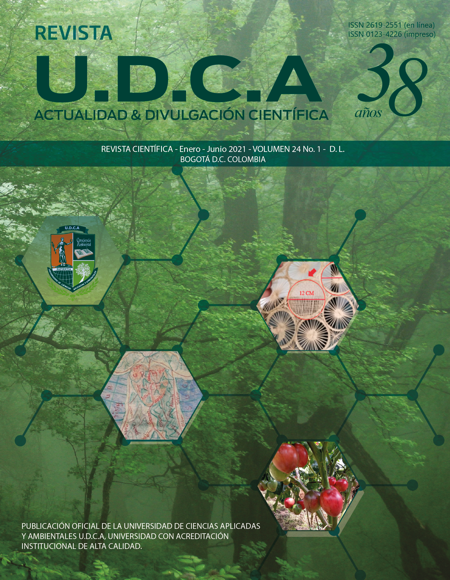Caracterización química, degradabilidad ruminal y aceptabilidad por bovinos, de un subproducto de la industria del papel
Chemical characterization, ruminal degradability and bovine acceptability of a byproduct of the paper industry
Contenido principal del artículo
Resumen
Las variaciones climáticas pueden limitar la disponibilidad y la calidad de los forrajes. Se estudió un subproducto del papel (SIP) como alternativa a los forrajes en la ración de los bovinos. Se analizaron 12 muestras de SIP, para determinar su composición nutricional y degradabilidad ruminal. La aceptabilidad (1,07kg MS) por los bovinos de los SIP solo o en mezcla, se evaluó en 12 novillas Holstein, asignadas a dos cuadrados latinos, cada uno con tres tratamientos y dos réplicas. En el primer cuadrado, los tratamientos fueron SIP solo (T1); SIP+glicerol (T2) y SIP+melaza (T3). En el segundo, los tratamientos fueron SIP+suplemento comercial (SC) (T4); SIP+SC+glicerol (T5) y SIP+SC+melaza (T6). Los SIP presentaron bajos contenidos de PC (1,5±0,14%) y altos niveles de FDN (56,9±6,17%) y cenizas (53,3±1,98%) y una DIVMO (47,7±5,8%) media. Las concentraciones de P (0,045±0,006%) y K (0,023±0,03%) fueron bajas, mientras que las de Ca (13,5±0,8%), Cu (63,9±11,5%) y Fe (1365±189ppm) fueron altas. La tasa de desaparición de la MS del SIP fue de 11,8%*h-1; la fracción soluble (a), 14% y la fracción potencialmente degradable y no soluble (b), 46,6%. La aceptabilidad del SIP fue mayor, cuando se ofreció en mezclas (T1 vs T2-T3; p<0,05) y con concentrado y melaza (T4-T5 vs T6; p<0,05). La variación en la calidad composicional del SIP fue menor para la mayoría de nutrientes y su calidad baja, debido a una digestibilidad media, una baja PC y altas cenizas. Además, su aceptabilidad fue pobre cuando se suministró sola, pero mejoró con el uso de palatabilizantes o SC.
Palabras clave:
Descargas
Datos de publicación
Perfil evaluadores/as N/D
Declaraciones de autoría
- Sociedad académica
- Universidad de Ciencias Aplicadas UDCA
- Editorial
- Universidad de Ciencias Aplicadas y Ambientales U.D.C.A
Detalles del artículo
Referencias (VER)
ANDI. 2019. Cámara de la Industria de Pulpa, Papel y Cartón. Informe de Sostenibilidad 2017. Primera edición. Radiografía de un sector comprometido con la sostenibilidad. Disponible desde internet en: http://www.andi.com.co/Uploads/Informe%20pulpa%20papel%20y%20carton%20version2019 (con acceso 6/11/2019).
ARC. 1980. The Nutrient Requirements of Ruminant Livestock. Commonwealth Agricultural Búreaux. Slough, (England). 351p.
ASSOCIATION OF OFFICIAL ANALYTICAL CHEMISTS, AOAC. 2006. Official Methods of Analysis of AOAC International. 18 ed. Animal Feed. (USA).
BAJPAI, P. 2015. Management of Pulp and Paper Mill Waste. Springer International Publishing. (Switzerland). 191p.
BERNAL, J. 2003. Pastos y forrajes tropicales. Manejo y producción. Cuarta edición. Ed. Ángel agro-Ideagro. (Colombia). 702p.
BHARGAVA, P.; ØRSKOV, E. 1987. Manual for the Use of Nylon Bag Technique in the Evaluation of Feedstuffs. Rowett Research Institute, Aberdeen. Scotland, (UK).
BRAVO, R.D.; ARELOVICH, H.M.; STORM, A.C.; MARTÍNEZ, M.F.; AMELA, M.I. 2008. Evaluación de métodos de amonificación mediante hidrólisis de urea sobre el valor nutritivo de paja de trigo. Rev. Argentina Producción Animal. (Argentina). 28(3):179-191.
CAVKA, A.; GUO, X.; TANG, S.; WINESTRAND, S.; JONSON, L.; HONG, F. 2013. Production of bacterial cellulose and enzyme from waste fiber sludge. Biotechnol. Biofuels (United Kingdom). 6(1):25.
https://doi.org/10.1186/1754-6834-6-25
CHUMPAWADEE, S.; SOMMART, K.; VONGPRALUB, T.; PATTARAJINDA, V. 2006. In Sacco degradation characteristics of crop residues and selected roughages in brahmanthai native crossbred steers. Kasetsart J. (Nat. Sci.) (Thailand). 40(1):204-214.
CONTRERAS, J.; MATOZ, M.; FELIPE, P.; CORDERO, F.; ESPINOZA, Y. 2019. Degradabilidad ruminal de forrajes y residuos de cosecha en bovinos Brown Swiss. Rev. Inv. Vet. Perú (Perú). 30(3):1117-1128.
COOMBE, J.; BRIGGS, A. 1974. Use of waste paper as a feedstuff for ruminants. Australian J. Experimental Agriculture and Animal Husbandry (Australia). 14:292-301.
CROY, D.; RODE, L. 1988. Nutritive value of pulp mill fiber waste for ruminants. Can. J. Anim. Sci. (Canadá). 68(2):461-470.
https://doi.org/10.4141/cjas88-052
ESPINOZA, I.; MEDINA, M.; BARRERA, A.; MONTENÉGRO, L.; SÁNCHEZ, A.; ROMERO, M.; GARCÍA, A. 2017. Composición bromatológica y degradabilidad ruminal in situ de residuos agroindustriales de maracuyá (Passiflora edulis) y plátano (Musa paradisiaca). Cienc Tecn UTEQ. (Ecuador) 10(2):63-67.
GOJÓN, B.; SIQUEIROS, D.; HERNÁNDEZ, H. 1988. In situ ruminal digestibility and degradability of Macrocystis pyrifera and Sargassum spp. in bovine livestock. Cien. Mar. (México). 24:463-481.
GÓMEZ, J.; CORREA, G.; BARAHONA, R. 2014. Evaluación del residuo del cultivo de Agaricus bisporus como alimento de vacas lecheras en lactancia media. Rev. Fac. Nal. Agr. Medellín (Colombia). 67(2):7331-7343.
https://doi.org/10.15446/rfnam.v67n2.44175
GOSELINK, R.; JONGBLOED, A. 2012. Zinc and copper in dairy cattle feeding. Wageningen UR livestock research partner in livestock innovations. report 519 (Netherland). 31p.
HAILE, E.; GICHEHA, M.; NJONGE, F.; ASGEDOM, G. 2017. Determining Nutritive Value of Cereal Crop Residues and Lentil (Lens esculenta) Straw for Ruminants. Open J. Animal Sciences. 7:19-29.
https://doi.org/10.4236/ojas.2017.71003
HOWARD, R.; ABOTSI, E.; JANSEN VAN RENSBURG, E.; HOWARD, S. 2003. Lignocellulose biotechnology: tissues of bioconversion and enzyme production. African J. Biotechnology. (Nigeria). 2(12):602-619.
IZUMI, K.; TAMURA, T.; FUJII, R.; NAKATSUJI, H.; MORITA, S. 2019. Effects of substituting kraft pulp with corn silage on dry matter intake, ruminal mat formation, rumen fermentation, and rumination activity in non-lactating cows. Anim Sci J. (United Kingdom). 90(2):205-213.
https://doi.org/10.1111/asj.13149
KUJALA, A. 2012. Papermaking sludge and possibilities of utilization as material. Bachelor Seminar of Environmental Technology. Lappeenranta University of Technology. Faculty of Technology. (Finland). 68p. Disponible desde internet en:
http://www.doria.fi/bitstream/handle/10024/73980/Kujala%20Asta_Kandidaatinty%C3%B6.pdf?sequence=1 (con acceso 15/11/2016).
MAEDA, Y.; NISHIMURA, K.; KUROSU, K.; MIZUGUCHI, H.; SATO, S.; TERADA, F.; KUSHIBIKI, S. 2019. Effect of feeding wood kraft pulp on the growth performance, feed digestibility, blood components, and rumen fermentation in Japanese Black fattening steers. Anim Sci J. (United Kingdom). 90(4):523-532.
https://doi.org/10.1111/asj.13182
MAHESH, M.; MOHINI, M. 2013. Biological treatment of crop residues for ruminant feeding: A review. Afr. J. Biotechnol. (Nigeria). 12(27):4221-4231.
https://doi.org/10.5897/AJB2012.2940
MARTÍNEZ, R.; MARTÍNEZ, N.; MARTÍNEZ, M. 2011. Diseño de experimentos en ciencias agropecuarias y biológicas con SAS, SPSS, R y Statistix. Tomo I. Primera edición. Fondo Nacional Universitario. (Colombia). 399p.
MÉNDEZ, A.; FIDALGO, J.; GUERRERO, F.; GASCÓ, G. 2009. Characterization and pyrolysis behavior of different paper mill waste materials. J. Anal. Appl. Pyrolysis (Netherlands). 86:66-73.
https://doi.org/10.1016/j.jaap.2009.04.004
MERTENS, D.; CAMPBELL, J.; MARTZ, A. 1971. Lactational and ruminal response of dairy cows to ten and twenty percent dietary newspaper. J. Dairy Science (USA). 54(5):667-672.
https://doi.org/10.3168/jds.S0022-0302(71)85904-0
MINISTERIO DE AMBIENTE, VIVIENDA Y DESARROLLO TERRITORIAL. 2005. Decreto número (4741) 30 de diciembre de 2005. “Por el cual se reglamenta parcialmente la prevención y manejó de los residuos o desechos peligrosos generados en el marco de la gestión integral". Disponible desde internet en:
https://diario-oficial.vlex.com.co/vid/decreto-4741-43232025?_ga=2.49572576.716973682.1573274357-1623162950.1573274357 (con acceso 05/11/2019).
MINISTERIO DE VIVIENDA CIUDAD Y TERRITORIO. 2014. Decreto número (1287) 10 de Julio de 2014. "Por el cual se establecen criterios para el uso de los biosólidos generados en plantas de tratamiento de aguas residuales municipales". Disponible desde internet en:
http://www.minvivienda.gov.co/Decretos%20Vivienda/1287%20-%202014.pdf (con acceso 05/11/2019).
MONTE, M.; FUENTE, E.; BLANCO, A.; NEGRO, C. 2009. Waste management from pulp and paper production in the European Union. Waste Manag. (United Kingdom). 29(1):293-308.
https://doi.org/10.1016/j.wasman.2008.02.002
MOSS, J.; EHRLICH, E.; BUCHANAN, K.; MARTIN, P. 1990. Evaluation of recycled paper pulp residue as a feed of cattle. Proc. Aust, Soc. Anim. Prod. (Australia). 18:316:319.
NATIONAL RESEARCH COUNCIL, NRC. 2001. Nutrient Requirements of Dairy Cattle: Seventh Revised Edition. National Academy Press. Washington D.C.
NISHIMURA, K.; KUROSU, K.; TERADA, F.; MIZUGUCHI, H.; SATO, S.; KUSHIBIKI, S. 2019. Effect of wood kraft pulp feed on digestibility, ruminal characteristics, and milk production performance in lactating dairy cows. Anim Sci J. (United Kingdom). 90(2):189-195.
https://doi.org/10.1111/asj.13131
NOCEK, J. 1988. In situ and other methods to estimate Ruminal Protein and Energy Digestibility: a review. J. Dairy Sci. (USA) 71(8):2051 2069.
https://doi.org/10.3168/jds.S0022-0302(88)79781-7
ØRSKOV, E. 2000. The in situ technique for the estimation of forage degradability in ruminants. In: Given, D.I.; Owens, E.; Axford, R.F.E.; Omed, H.D. (Eds.). Forage evaluation in ruminant nutrition. CAB International (Wallingford). p.175-188.
ØRSKOV, E.; DEB HOVELL, F.; MOULD, F. 1980. The use of the nylon bag technique for the evaluation of feedstuffs. Trop. Anim. Prod. (Netherlands). 5(3):195-213.
ØRSKOV, E.; MCDONALD, I. 1979. The estimation of protein degradation in the rumen from incubation measurements weighted according to rate of passage. J. Agric. Sci. Camb. (USA). 92:499-503.
https://doi.org/10.1017/S0021859600063048
TILLEY, J.; TERRY, R. 1963. A two stage technique for in vitro digestion of forage crops. J. Br. Grassl. Soc. (Australia). 18:104-111.
VAN SOEST, P.J.; ROBERTSON, J.B.; LEWIS, B.A. 1991. Methods for dietary fiber, neutral detergent fiber, and nonstarch polysaccharides in relation to Animal nutrition. J. Dairy Sci. (USA). 74:3583-3597.
https://doi.org/10.3168/jds.S0022-0302(91)78551-2
VAN SOEST, P. J. 1994. Nutritional Ecology of the Ruminant. 2nd ed. Cornell University Press, Ithaca, NY. 476p.
VILLAS-BÔAS, S.G.; ESPOSITO, E.; MITCHELL, D. 2002. Microbial conversion of lignocellulosic residues for production of animal feeds. Animal Feed Science and Technology (Netherlands). 98(1-2):1-12.







